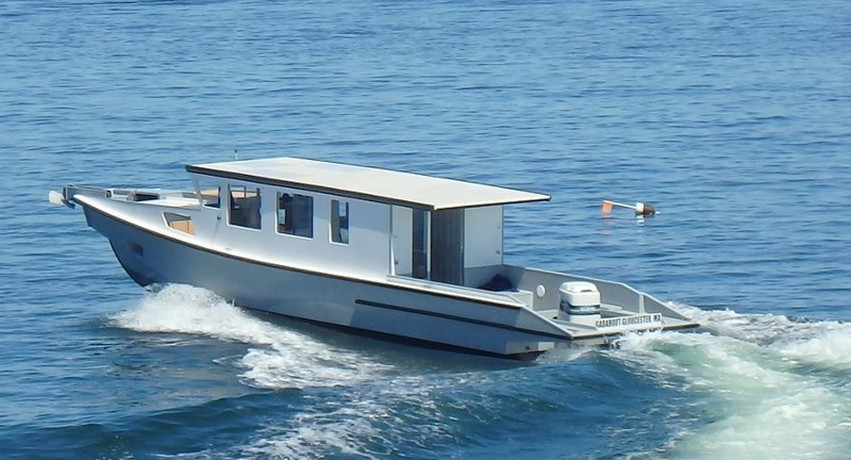
By Susan Altenburger
Gadabout came about after the US Navy asked Phil Bolger & Friends Inc. (PB&F) to develop a container-transportable power cruiser. This was a rather irresistible opportunity. We had been developing a modest sequence of design concepts to match a variety of unusual requirements for the Navy. This time they wanted us to design this craft, and manage the prototyping of the project from the earliest stages of construction to final testing. While our design office had never built anything bigger than perhaps 16 feet, we understood the basics of how any design would be built.
In pursuit of a collaborative model, the US Navy would put up a modest budget which would then be matched by the City of Gloucester. The Navy would stretch its limited research funds, and the City would get to explore working with this most potent marine industrial partner — a rare opportunity for marine-industrial development. If successful, this first modest step might result in increasingly more ambitious collaborations in the future.
This was the brief:
- Can this patrol craft design be built as a prototype for the US Navy by Gloucester low-income non-boatbuilders to adequate quality and performance?
- If so, the US Navy would take these plans and the well-illustrated construction manual overseas to help poorer nations build their own riverine and inshore patrol craft.
- Later these crews could repeat the effort on larger or smaller scales to match their particular needs.
The US Navy has an extensive network of friendly overseas partners, including those who cannot necessarily afford to buy boats that are built in highly industrialized, high-wage nations. By selecting plywood, epoxy, fiberglass, and closed-cell foam core as construction materials, an untrained building crew can complete the project under rudimentary conditions with little industrial infrastructure.
To support the project development, the Navy would first build the #2 hull on a US naval base as a test of the construction manual, and an opportunity for Navy staff to learn the process so they could eventually serve as instructors overseas. For the hulls built far away, the Navy would fill containers with all the materials, hardware, and consumables necessary, slide the #2 hull into its own 40′ ISO container, and these steel boxes would be shipped to the partners’ locations. Once these containers had arrived, the instructors would fly in, pull the materials out and demonstrate the remaining construction process. This would build motivation among the local Navy/Coast Guard boatbuilding apprentices, and they’d get going on the first local copies.
Apart from the convenience of shipping the #2 hull as a model for overseas partners, the Navy wanted the general tactical utility to ship fully assembled boats anywhere. This way they could open innocuous-looking containers and quickly launch a military craft. Therefore, the design had to match the internal dimension of the standard 40′ box, starting with the door opening. Getting the most boat into the box would be one of the leading design goals, leaving just enough room for low-key insertion and extraction. To match a standard ISO 40′ shipping container, the boat would measure:
- 39′ 1″ length (vs. 39′ 6″ available)
- 7′ 5″ width (vs. 7′ 8″)
- 7′ 3″ height (vs. 7′ 6″)
- 6500 lbs empty and dry
- 225 hp outboard and 200 gal of fuel for 20-25+ kts depending upon load
As an inshore and coastal craft, patrolling for days on end with a crew of two to four, this boat called for two bunks, a modest galley, and a private head. On shorter runs, eight additional troops would be carried, deployable to the beach via the bow gate. Her bow cockpit was designed to carry a swivel-mounted .50-cal MG or Mk.19 40 mm grenade launcher system and gunner. Additional weapons would be carried by military crew members.
What had started as a promising collaboration between the US Navy and the City of Gloucester began to suffer under the increasingly severe fiscal consequences of the Great Recession. There would never be more than 55% of the original budget for the Gadabout project. Soon, instead of four, only one person remained on the job. Then, without any more funds for even a boat shop, the partially finished project had to be moved outdoors in the New England winter. Without a matching budget, our bills for materials, hardware, and labor would really add up.
The project eventually became the property of PB&F. Before Gadabout was even completed, private interests snapped her up as a well-subsidized good deal that was already demonstrating success:
- Gadabout had indeed been built by non-boatbuilders from Gloucester in full public view.
- She has been constructed using 90% sustainably sourced hull materials using US farm-grown Douglas fir marine-grade plywood.
Why does the latter matter? Beyond the US Navy interests, PB&F wanted to demonstrate that this low-carbon design and construction technology was also a reasonably “green” approach. 21st Century, low-carbon, “green” commercial boat building could help reestablish Gloucester’s fishing fleet and port sustainability. Fishermen would be eager to obtain an advanced boat while saving a lot of money.
We mimicked the non-industrial construction approach that would be the norm overseas. We used an unseasoned crew and worked ourselves into the construction process. We learned skills building the smaller pieces, which we applied building dozens of increasingly larger parts.
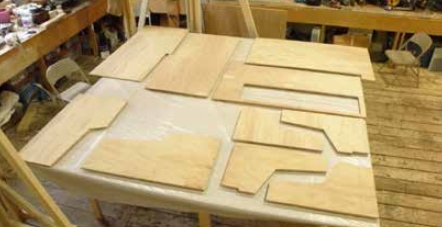
We used WEST SYSTEM 105 Resin, 205 Hardener, and the very portable 306 Metering Pump. The larger 305 Positive Displacement Pump was indispensable for large-area bonding operations such as rapidly adding plywood layers in one shot along the full length of her topsides and hull bottom panels, and for wet layup of several layers of fiberglass cloth at once. The pumps allowed us to work quickly enough to get through the laminating process before the epoxy could cure. There were times when three crew members would rush to spread epoxy and handle the fiberglass while the fourth produced a steady flow of mixed resin and hardener. Any slowdown or interruption would have resulted in a waste of expensive materials and additional man-hours to clean up the mess and repair any damage.
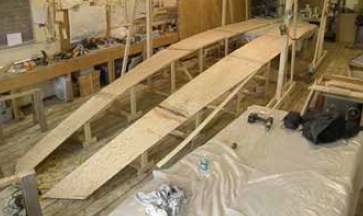
Because we needed to maintain a low-tech approach in building Gadabout, instead of vacuum-bagging our laminates we installed lots of drywall screws to temporarily secure pieces and apply clamping pressure. This required us to make frequent late-night runs to the project in order to unscrew the fasteners before the epoxy fully cured, grabbing them for good. We found it slow and tedious to have to heat each fastener with an electric soldering iron to overcome the epoxy’s tenacity before removing fasteners using a power screwdriver. An easier option would have been to wax the screw before fastening the laminates to prevent the epoxy from adhering to the screw when cured.
Even the largest individual piece, the bottom, and V-nose assembly would be fully glassed and painted before we turned the boat right-side-up to receive the prepared frames, bulkheads, transom, topsides, etc. Unfortunately, by that time the project crew was down to just me and one other person, and then to me alone. With such a small crew, Gadabout‘s assembly took longer than planned.
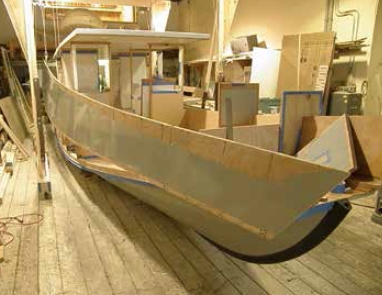
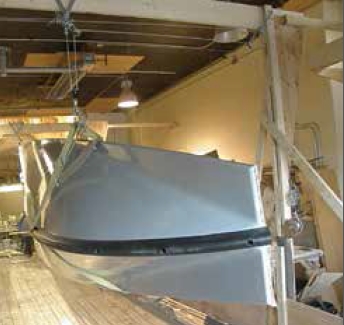
Nevertheless, by the time she was done all of the outside surfaces had at least one layer of 10 oz. fiberglass cloth and the topsides and hull bottom had several layers. Even with all her plywood and a fair number of foam panels laminated into her structure, she would have over 2000 lbs of positive buoyancy offsetting the heavier-than-water weight of fiberglass, epoxy, outboard, batteries, ground-tackle, weapons, etc. —making her harder to sink after taking bullets under her waterline.
It was gratifying to finally see Gadabout come alive. We enjoyed feeling her out at increasing speeds, then taking her out into the bay, the assault-landing simulations with some local veterans, family outings, and just plain showing her off to pleasure boaters and the working waterfront alike.
Starting with a CAD-based design, built by non-boatbuilders using US-sourced plywood and epoxy, she was completed and is expected to serve her owners for as long as they will care about boating.
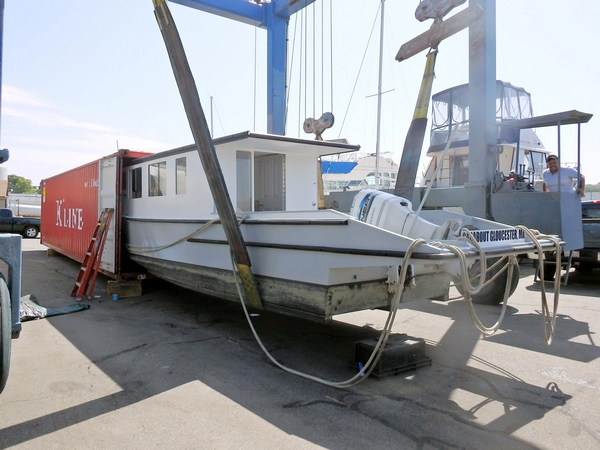
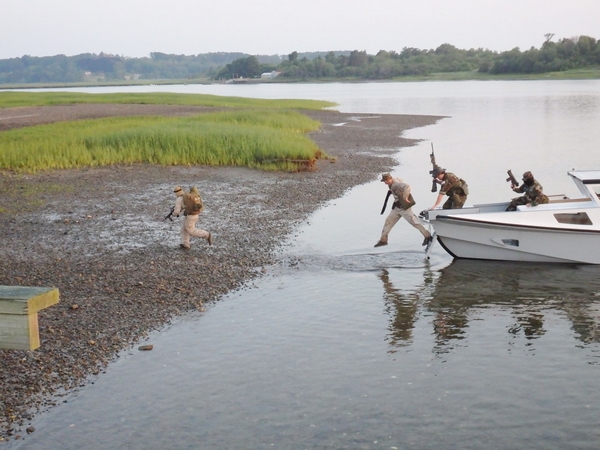
Susanne Altenburger, Phil Bolger & Friends Inc. (PB&F), Boat-Design since 1952

